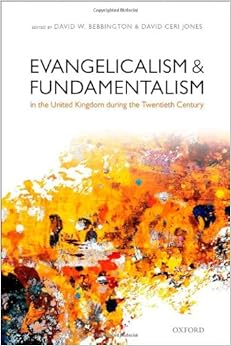Evangelicalism & Fundamentalism
in the United Kingdom during the Twentieth Century
Edited by David Bebbington and David Ceri Jones
Oxford: Oxford University Press, 2013
ISBN 979-0-19-966483-2
Hbk, xiii+409pp, £72.01
It has been the received wisdom that fundamentalism is largely an American phenomenon that has had little impact on British evangelicalism. Here David Bebbington and David Ceri Jones have complied a volume looking at the relationship of evangelicalism and fundamentalism in Britain.
Bebbington is well know for his seminal Evangelicalism in Modern Britain and Jones is co-author of The Elect Methodists and is working on a history of evangelicalism in Wales, so both are well equipped to edit this volume.
Fundamentalism has been described as ‘the crypto-zooology of the theological world. It need not be argued against. It can be dismissed.’[1] Fortunately, in this volume it is not dismissed but examined in the light of the evangelical movement in Britain. Both fundamentalism and evangelicalism are notoriously difficult to define. The most oft-quoted definition in this book is Marsden’s tongue in cheek definition of fundamentalists as ‘evangelicals who are angry about something’ (cited in, for example, pages 116, 148, 231, 255, 339, 351, 363). Perhaps evangelicalism is then fundamentalism made more socially acceptable. Or as John Mark Reynolds, cited by Holmes, puts it an evangelical is ‘a fundamentalist who watches The Office.’ Or Marsden's (1980) ‘a mosaic of divergent and sometimes contradictory traditions and tendencies that could never be totally integrated’. Like the soap in a bath it is difficult to get a hold of - and very slippery.
Nevertheless, these authors all make an excellent attempt to examine British evangelicalism to see if there are any fundamentalist tendencies in it. Most think not. Though, of course it depends how each is defined. Some see the relationship as intersecting sets (e.g. Holmes), for some the intersection is an empty set, others as a spectrum of views (eg Warner).
The majority of the book is devoted to historical case studies. Warner and Holmes take a broader look and examine statements of faith and theological perspectives.
The Fundamentals the 12 volumes that were largely responsible for the fundamentalist movement so it is fitting that the first chapter takes a look at the British contributions to it. Treloar notes that there were 17 British contributors (out of the 90)who contributed about 400 of the 1400 pages. This alone shows that fundamentalism isn’t just an American phenomenon. He proceeds to provide brief biographies of the contributors.
One of the contributors was Thomas Whitelaw of Kilmarnock and he is the subject of the next chapter. One interesting chapter is that on Methodism. Its inclusion is intriguing as the Methodists are hardly renowned for their evangelicalism let alone fundamentalism, but Wellings identifies one small group that did have fundamentalist tendencies.
One of the editors of the Fundamentals was A.C. Dixon - at one point he moved to England to Spurgeon's Metropolitan Tabernacle. It is surprising then that he didn’t play a greater role among the British Baptists. Bebbington provides a helpful look at the Baptists and Andrew Atherstone at the Anglicans - both of them deal with the inter-war years.
One key characteristic of the fundamentalists is their anti-Catholicism stance this is taken up by John Maiden. Surprisingly is the inclusion of a chapter on women. Surprising as women were often overlooked by the predominantly male leadership. Wilson provides an excellent analysis of female involvement in fundamentalism, in particular Mrs Horrocks and Elizabeth Morton.
The section on the later twentieth century includes chapters on John Stott and Billy Graham. A sociological exploration of new churches in York brings the narrative up to date. A surprising omission is a chapter on D.M. Lloyd Jones, particularly as Jones is the editor of a volume on him. But then the omission may be overlooked in that there is book on him! The National variations section deals with the Ulsterman W.P. Nicholson, Scotland and post-War Wales.
The final section on theological reflection looks at Pentecostalism, evangelical bases of faith, and theology.
For those with an interest in twentieth-century evangelicalism this book is a treasure trove. The book is replete with sources and avenues for further research. The book deserves a wider reading than the price tag would permit.
The majority of the chapters appear in this volume for the first time, those by Bebbington, Randall and Tidball are reprints of articles published first elsewhere. Each chapter has its own footnotes and there is a useful 17-page bibliography and an even more helpful 15-page index.
[1] Bauder, K.T. 2011. In Four Views of the Spectrum of Evangelicalism ed. A. D. Naselli and C. Hansen. Zondervan.
Subscribe to:
Post Comments (Atom)


No comments:
Post a Comment